
Where to stay in Barcelona: Barceloneta neighbourhood
Barcelona what to see: “BARCELONETA”
Barceloneta is definitely a must-see neighbourhood when you are coming to the city. Not only because it’s an old quarter with unique streets – everyone hang the clothes from the balconies because the flats are really tiny – and it’s right next to the beach, but also because it’s full of life, there are great restaurants, bars, and it’s specially known for its nightlife.

What to do in Barceloneta?
Here’s a list of 1o things you can do while in Barceloneta:
- Passeig de Joan de Borbó & Moll De La Fusta
- Museu d’Història de Catalunya
- Plaça de la Barceloneta & Sant Miquel del Port Church
- Barceloneta Market
- Barceloneta Park
- Playa de la Barceloneta, Sant Miquel, Somorrostro & Sant Sebastian
- Port Cable Car
- Hotel W
- The Wounded Shooting Star
- Passeig Marítim de la Barceloneta
Should I stay or should I go?
- If you like party & want to be next to the biggest discos in town.
- If you want to be next to the most popular beaches.
- then you should stay in Barcelona…
How to get to Barceloneta?
- Metro L4 Barceloneta
- Buses V15/V19 to Barceloneta beach
Little history about Barceloneta
La Barceloneta is a neighborhood of seafaring origins in the Ciutat Vella (Old City of Barcelona). It was built during the 18th century and initially designed by the engineer Próspero de Verboom, in 1719, in order to make room for the inhabitants of the La Ribera neighborhood (El Born) who had lost their homes. Philip V ordered to demolished all the houses from that area to build a military citadel, nowadays the Ciutadella Park.
Passeig Joan de Borbó
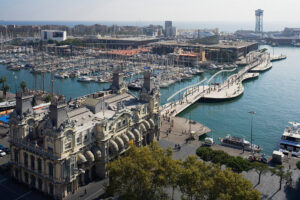

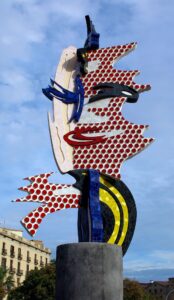
The Passeig de Joan de Borbó in Barceloneta district, the old fishermen’s quarter, was built in an area that was previously almost uninhabited: it was due to its proximity the sea that the fisherfolk were the first to settle in this part of the city.
You can start exploring Barceloneta neighbourhood from pop artist Roy Lichtenstein’s Barcelona Face sculpture.
- First thing you will see is the old port of Barcelona (Port Vell), with those super yachts.
- If you follow Passeig de Joan de Borbó until you get to the beach, you will get to Barceloneta beach, Sant Miquel, Somorrostro & San Sebastian where the Port Cable Car to Montjuic mountain and W hotel.
- In the way you’ll find many seafood restaurant and of course, people walking, skating and cycling.
Walking towards the other side, opposite to the beach, you will find:
- this coastal walkway “Moll de la Fusta”, where the Maremágnum shopping centre and the Columbus viewing point.
- You will access Maremagnum walking along Rambla de Mar (Sea Ramblas) the continuation of Las Rablas.
- From Columbus viewing point you can take the popular “Las Golondrinas”, these passenger wooden, double-decker, open -top boats. These traditional boats are designed to navigate calm waters. Price from 8€
- On the upper level of the former docks there used to be several restaurants but these have since disappeared. One of these was the Gambrinus Restaurant and its roof was capped with a gigantic 15-metre long prawn. This prawn was the work of the designer Mariscal and it is currently owned by Barcelona City Council, which decided to keep it at the original location even though the restaurant is no longer there. Today, it is one of the city’s most curious icons.
Museu d’Història de Catalunya
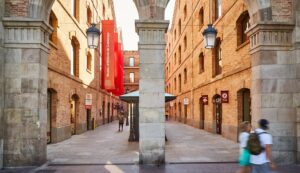
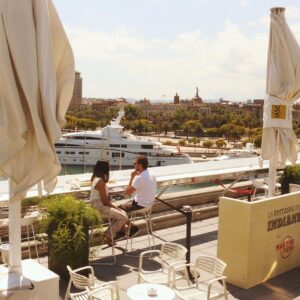
Plaça de la Barceloneta & Sant Miquel del Port Church
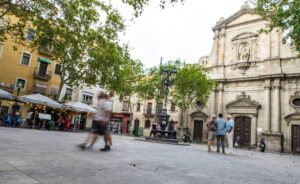
The church of San Miguel del Puerto was conceived as a parish for the new neighborhood of Barceloneta, built in 1753 by Juan Martín Cermeño. This is a charming square nowadays, with a traditional water fountain in the middle in case you want to refill your bottle and some local seafood bars and cafes around to enjoy the sun.
Barceloneta Market
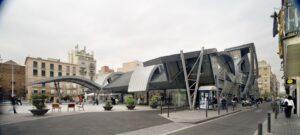
The Market has always been an element of social cohesion in the neighborhood, a landmark. Actually each neighbourhood in Barcelona has a market.
La Barceloneta Market or “Mercat de la Barceloneta” in Spanish, is the biggest fresh food market in the Barceloneta neighborhood. The market was recently renovated and there are plenty of fresh food, fruits, vegetables, meat (including cured meat) and fish on sale. You can find tapas and cafes. Several stalls will cook and prepare food for you. The market is well worth a visit if you are staying at the nearby beach.
Barceloneta Park
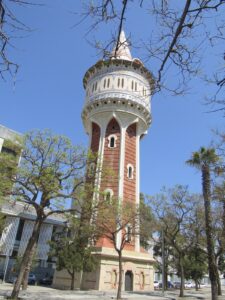
This green space serves as a communication link between the ring road and the beach. The park is organised into three large areas. The first, built around the remains of an old gas tank, is an open space, while the second consists of large slopes, separated by paved paths, and the third is the site of a football pitch.
The architects who designed the park, Jordi Henrich and Olga Tarrasó, made the most of some parts of the old gas factory, which was working here right up to 1989. They conserved the laminated steel structure of the gasometer (designed by the engineer Claudi Gil Serra in 1868) and the water tower (designed by the Modernista architect Josep Domènech i Estapà), which was built in 1905. The third element they conserved was the factory itself, by the Passeig de Salvat Papasseit entrance. Like the water tower, this building was designed by Josep Domènech i Estapà. It was built in 1907, to house the Catalana de Gas management’s offices.
Today it houses Fàbrica del Sol, literally the “Sun Factory” and actually the Barcelona Sustainable Resources Centre, whose facilities are dedicated to environmental education.
Playa de la Barceloneta, Sant Miquel, Somorrostro y Sant Sebastiá
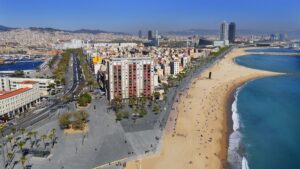
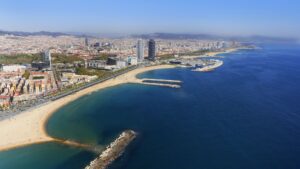
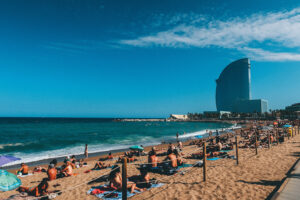
Together Barceloneta, Sant Miquel, Somorrostro & Sant Sebastiá, these are the city’s oldest and most traditional beaches. Club Natació Atlètic-Barceloneta is located here in Barceloneta, with indoor and open air swimming pools, solarium and sport areas. Like all the beaches in Barcelona, we have here public toilets, showers, sun loungers & beach umbrellas. Be aware that Sant Sebastià (as Bogatell & Mar Bella Beach) has a nudist area and nowadays smoking is prohibited on the beach!
Port Cable Car
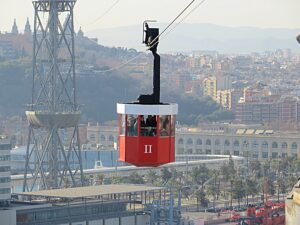
If you are looking for truly amazing views of Barcelona, here near Hotel W we have Sant Sebastian tower. From here you can take the Port Cable Car and travel during 8 minutes above the mediterranean coast towards Montjuic Mountain or viceversa. Once you are in Miramar hotel, the views of the harbour during sunset are really cool. From here you can start your journey all along Montjuic. Check here the best guide on how to visit Montjuic Mountain.
- One way: 11 euros
- Round trip: 16.50 euros
Hotel W & Viewpoints

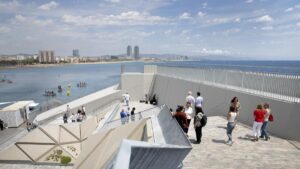
The W Barcelona Hotel, this 5-stars hotel, popularly known as the Hotel Vela (Sail Hotel) due to its shape, is a building designed by Ricardo Bofill located in the expansion of Barcelona’s port. It stands in 7 hectares of land reclaimed from the sea surface in the construction of the new entrance to the harbour. It is also known to resemble the Burj Al Arab of Dubai, United Arab Emirates.
It is right next to Sant Sebastiá beach in Barceloneta, and it offers breathtaking design and fantastic views over Barcelona. It’s 20 minutes’ walk from Barceloneta Metro Station, and buses stop outside the hotel. Also from here you can take the Port Cable Car towards Miramar Hotel in Montjuic mountain.
Barcelona has inaugurated some stairs and a viewpoint next to the sea front of the Hotel W, designed by the architect Carmelo Zappulla. These stairs connect Plaça Rosa dels Vents and Nou Passeig del Trencaones with Platja de Sant Sebastià.
The Wounded Shooting Star (L’Estel ferit)
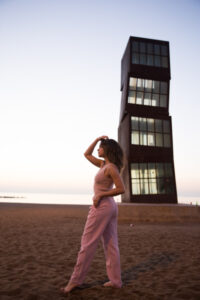
This sculpture consists of four twisted cubes, stacked seemingly at random. Most people refer to this popular landmark as “Rebecca cubes” because it was designed by the German artist Rebecca Horn. Its symbolism is inextricably linked to the past of the Barceloneta district. The sculpture pays tribute to Barcelona’s fishing district.
Some people say that the cubes represent the 30m2 apartments, known locally as quarts de pis, which were built at the end of the 19th century. It was 1992, and the city’s most neglected neighbourhoods were in need of a clean up, while they opened up to the sea and adorned themselves with sculptures that were often innovative.
Passeig Marítim de la Barceloneta

This is a 1.25km promenade from Barceloneta to the Port Olímpic. Ideal for strollers, runners and sun-seekers. Along the promenade there are tall palm trees with benches. You can walk or cycle on a separate path nearby. Packed in the summer, though it’s beautiful during sunset all year round.
Barceloneta nightlife
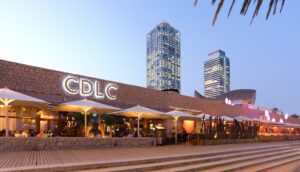
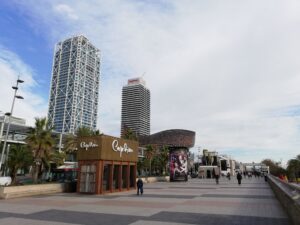
If you walk all along Passeig Maritim towards the Frank Gehry’s sculpture “The Fish” and the two towers “Hotel Artz & Mapfre tower”, right beneath them you’ll find the famous beach clubs:
- Carpe Diem
- Opium
- Shoko
- Bestial
- Pachá
Where to eat in Barceloneta?
- Download my Barcelona Travel Guide by neighbourhood and check my favourite places in Barceloneta!
Hope this help you to get around in Barcelona! Please leave your comments below if you have any questions or any better idea 🙂



